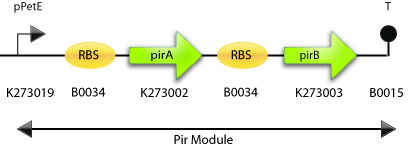Team:Uppsala-Sweden/pir
From 2009.igem.org
m |
m |
||
| Line 9: | Line 9: | ||
==The Constructs== | ==The Constructs== | ||
| - | + | <partinfo>BBa_K273002</partinfo> and <partinfo>BBa_K273003</partinfo> : The desired Construct for Testing Purposes | |
Revision as of 12:33, 20 October 2009

The Theory
The protein Pirin has in Serratia marcescens been shown to regulate the pyruvate levels by means of inhibition of the PDC [1]. While the Pirin superfamily is diverse and has different functions across organisms it has been linked to growth inhibition in Synechocystis sp. PCC 6803 [2]. One could theorize that it does this in the same way as in S. marcescens, by inhibiting the PDC and thus choke the Krebs cycle. In S. marcescens this leads to induction of fermentation pathways.
As a side effect we have found data on the ethanol resilience of Synechocysti, obtained through a test of induction of Pirin by ethanol stress [2], it is here shown that ethanol up to 5% in the growth media has a positive growth effect while it is detrimental to growth at 7.5%. Inhibited growth may be accepteble to us as we would typically be at optimum population density during ethanol production in either case. This propose that we could tolerate concentrations higher then 7.5%.
The Constructs
and : The desired Construct for Testing Purposes

References
 "
"



